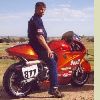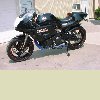| Author |
Message |
    
Firemanjim

| | Posted on Thursday, November 25, 2004 - 10:53 am: | 





|
Jim,check out this site.It gives specs on a bunch of sportster cams.I spoke with Leinewebber when I was doing my motor and he was not planning to do any sportster cams for several months ,but said the specs were the same as listed for his big twin turbo cams.I just compared them to the list and got the closest to them.One of the Red Shift, but don't have model # handy as I am at work.
Also,spoke with Steve at the Turbo Doc,he has another source for aerocharger style turbos again and will have sizes for Buells etc soon. |
    
Vr1203

| | Posted on Thursday, November 25, 2004 - 12:03 pm: | 





|
I never found a cam that had low overlap numbers and big lifts. I guess you could buy them loose, time them for less overlap and weld them up? And I read turbo books that made a point to use stock cams for the best result. I now think that these books are mostly for cars and that reasoning will not work as well for bikes, being they are lighter and I'm looking for max power. I now have a #114 turbo up from a #90,two sizes bigger. Steve promised me a new one this time last year to be delivered in June '04. June came and went.I gave up and bought this used one.Leineweber says he's willing to make a set now, its alot of money. He should know what he's doing????I don't want a big hole in the power band, like I had with the .497's. Aaron thanks for the offer, but I didn't plan on pulling the heads or the motor. I really only have a couple of hundred miles on the rebuild. |
    
Aaron
| | Posted on Thursday, November 25, 2004 - 01:03 pm: | 





|
RS585's don't look like a bad turbo grind to me. Only 40 degrees of overlap (.497's have 52), tdc lifts are only .205/.155, .580 of lift and a fairly-late 59 degree intake close event. Yeah, you're right, you could weld'em yourself and retard the intake lobe a bit to take out some overlap and delay the close even more. I've got the specs listed on this page. |
    
Firemanjim

| | Posted on Thursday, November 25, 2004 - 08:40 pm: | 





|
Oops,forgot to put in link,sorry.
http://www.nightrider.com/biketech/camxlbyman.htm |
    
Lornce

| | Posted on Sunday, December 12, 2004 - 10:21 pm: | 





|
Am interested to hear from anyone with experience of 88" kits on their Buells.
Been humming and hawing a while now about kitting the S2 or S1 and wondered about reliability issues.
Other day dropped in on a buddy who races an 88" X1 and he showed me a broken Millenium cylinder barrel. Appears to have cracked horizontally in line with the top surface of what's left of the engine case (after boring for 88" fitment) and then running vertically down to the edge of the cyl. sleeve spigot.
Is this sort of failure common?
TIA for any offered information.
Lornce |
    
Lgpch
| | Posted on Wednesday, April 20, 2005 - 06:35 pm: | 





|
I was reading up on the NOS sight and they were saying that NOS is safe if you do not exceed the horsepower limits that your motor can handle.
So my question is, if the stock motor has a claimed 101 horses at the crank, then how much more can the motor handle? Furthermore, how much closer does NOS get you to that limit? Not that you want to get close to it.
I have a 2000 M2 with Force air cleaner, V&H exhaust, Mikuni 42, and Andrews N-8's. |
    
Rick_a
| | Posted on Thursday, April 21, 2005 - 12:59 pm: | 





|
The "limit" depends on how long you expect your motor to live.
From calculations I've done based on BMEP's for different motor combinations and a guide I have about 110 hp is the limit for a stock displacement 1200 and like stock durability. 125 and up would be heading towards the race only motor range. Between those numbers was a BMEP giving what was termed as "fair" engine durability. There's a ton of other factors, so I'd call it a rough guide at best. (BTW that's RWHP)
I'm sure there are plenty of people here who should be able to tell you from personal experience, which is probably a whole lot more valuable than a few hypothetical calculations.
(Message edited by Rick_a on April 21, 2005) |
    
Vr1203
| | Posted on Friday, April 22, 2005 - 01:39 am: | 





|
NOS at 12HP per cylinder with cast pistons should be OK, 15HP with forged. Change the NOS /fuel jets to get what you want. You are only using it at full throttle anyway , so there is no problem unless you're riding on some salt or something like that. |
    
Shotgun
| | Posted on Sunday, April 24, 2005 - 02:45 pm: | 





|
Back to that 'rule of thumb" weight/horsepower question. There's got to be a better rule of thumb than "about 7 pounds of weight removed from a bike = about 1 HP". For example, small displacement bikes like my Derbi GPR 50. Probably makes 10 HP. Me and the bike together weigh about 400 pounds. A lightweight riding the same bike would weigh in at 260, or 140 pounds difference. Using the 7# to 1 HP rule, he'd have a 20 hp advantage on me. But we each only have 10 HP to start with!
So the question is, what would be a more accurate rule of thumb? |
    
Rick_a
| | Posted on Thursday, April 28, 2005 - 12:57 pm: | 





|
Well, the stopwatch never lies. |
    
Snowdave
| | Posted on Friday, May 06, 2005 - 12:11 am: | 





|
Se7enth_sign:
I too am just now building an 88 and was wondering about ported XB heads vs. STD heads. When I looked at the combustion chamber of my Thunderstorm heads through the new cylinders, I was surprised to see the size of the combustion chamber compared to bore size. This tells me that there is a lot of power being left on the table. Valve angle could be flattened. You could use larger valves, etc. Considering the STD prices are pretty good, I have the completely unqualified opinion that they would be better than the XB heads. I don't have a clue on mounting them for the front mount, though.
I currently have ported T-storms, so I will be running these for a while. I will need to save some more money for heads and new cams....that's next year.
Dave |
    
Skulley
| | Posted on Sunday, June 26, 2005 - 11:03 pm: | 





|
This looks like a good start for a winter project.
http://www.rbracing-rsr.com/hdturbob18l.htm
"Sportsters and Buells are pogo sticks when turbocharged. If you like wheelstands, then turbos are your breakfast lunch and dinner." |
    
Panic
| | Posted on Saturday, July 23, 2005 - 09:57 am: | 





|
Re: turbo cams. Vizard has some very interesting thoughts on valve events for turbo motors (originally for Chevy, but should be generally applicable). Key points:
1. negative overlap (long period around TDC with both valves closed)
2. very mild duration: intake (200, set -35/55), exhaust 234, 54/0, LSA 126
3. short events probably need high ratio rockers for flow |
    
Vr1203
| | Posted on Saturday, July 23, 2005 - 04:54 pm: | 





|
Hi, Yes negative overlap shows promise but I think in reality it wouldn't work very well.I'm using stock "D" Sportster cams ,they have single digit overlap numbers. I did not get Leineweber to grind my camshafts, and given up on him. I finished reconfiguring my turbo vane actuator today, I'm seeing 15psi and I can dial any amount I want. It does wheel stands at 70mph! Unfortunately,I separated my shoulder last week and when the bike came back down it really crunched it. ouch! |
    
Buellistic
| | Posted on Saturday, July 23, 2005 - 07:25 pm: | 





|
Horsepower is an illusory mathmatical equation ???
TORQUE is real !!!
In BUELLing
LaFayette |
    
Firemanjim
| | Posted on Thursday, July 28, 2005 - 08:55 pm: | 





|
Jim,tell me about this "reconfiguring my vane actuator" deal.Sounds interesting. |
    
Vr1203
| | Posted on Friday, July 29, 2005 - 11:54 am: | 





|
I thought you'd never ask!
OK, I figured I was having three problems,
one; If I backed the stop screw out to increase the starting boost I was getting too much back pressure in the exhaust making the bike run poorly under no/low boost conditions.
two; My little actuator had a spring that was too light, and shimming it had little effect, in increasing boost,I have the little one because of fitup constraints under the bike.
three; I had a theory that the vanes were moving from the exhaust pressure and my little spring could not cope
So I devised a electric control mechanism. Two three-way 12V solenoid valves and an adjustable boost switch. I drilled and tapped the back side of the actuator for a rubber hose fitting. (I think the big ones have this fitting already).
This is connected to the intake, for vacuum. It is controlled by a valve to be operated by the boost switch. When the engine is at idle or cruising the intake vacuum opens my vanes, no back pressure! When I start to make boost,that line becomes pressurized and closes the vanes. The more boost I make the harder it holds the vanes closed. At the boost pressure I select, that line is closed,vented and the top of the actuator line valve opens to the plemum pressure and opens the vanes. Sounds kind of complicated ,but it works, I can send you the part numbers and a diagram. |
    
Vr1203
| | Posted on Thursday, August 04, 2005 - 02:20 am: | 





|
So... Firemanjim ,what do you think? Its really nice , I just adjust the boost switch anywhere I want . It will open the vanes then and only then.And no backpressure in the off/low throttle positions. |
    
Firemanjim
| | Posted on Tuesday, August 09, 2005 - 03:07 am: | 





|
Sounds interesting,Jim.But as I am concerned with wide open only probably not for me.
On another note,just waiting for proper length nitrous lines to test my system.Every thing else is mounted and tank is full of haha gas. |
    
Vr1203
| | Posted on Wednesday, August 10, 2005 - 01:50 am: | 





|
FMJ, NOS ? Wow, you really have the "need for speed" ! Actually I had thought of it, but I have a limit on the complexity that I can cope with. The water injection works as a intercooler without the bulk and intake restriction , you might consider the Aquamist system,if you are using the NOS to help with cooling more than power. |
|